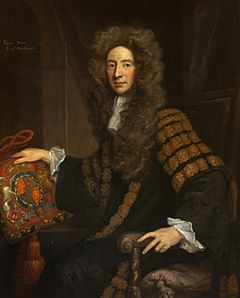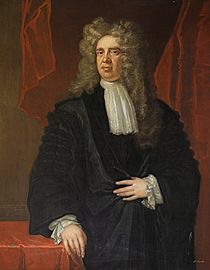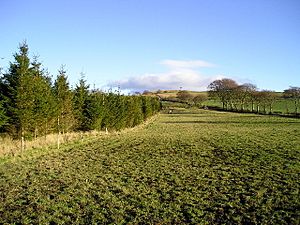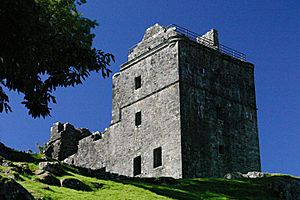Argyll's Rising facts for kids
Quick facts for kids Argyll's Rising |
|||||||
|---|---|---|---|---|---|---|---|
 An illustration of Argyll's capture |
|||||||
|
|||||||
| Belligerents | |||||||
| Commanders and leaders | |||||||
| John Murray George Douglas |
Archibald Campbell Patrick Hume John Cochrane (POW) Duncan Campbell Richard Rumbold John Ayloffe |
||||||
| Strength | |||||||
| c. 10,000 | 1,500–2,500 | ||||||
| Casualties and losses | |||||||
| Unknown | Unknown killed and wounded 323+ captured |
||||||
Argyll's Rising, also known as Argyll's Rebellion, was a short uprising in Scotland in June 1685. It was an attempt to remove James II and VII from the throne. James was a Catholic, and many Protestants did not want him to be king.
The rebellion was led by Archibald Campbell, 9th Earl of Argyll. He hoped to keep the King's forces busy in Scotland. At the same time, another rebellion was planned in England by James Scott, 1st Duke of Monmouth. Both rebellions wanted to stop James from being king.
Argyll, who was the leader of Clan Campbell, planned to gather thousands of men from his lands. He also expected help from other Protestants who disagreed with the King. He sailed from Holland in May with about 300 men. But when he landed in Scotland, not many people joined him. The rebellion struggled because Argyll was not an experienced military leader, and the rebel leaders often disagreed. Government soldiers, led by the Marquess of Atholl, chased them. By mid-June, the rebels started to give up and go home. Most of their leaders were captured, including Argyll, who was executed on June 30.
Contents
Why Did Argyll Rebel?
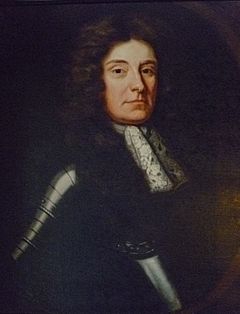
In February 1685, James II and VII became king. He was a Catholic. Many people in his kingdoms supported him at first, hoping for peace and stability. His daughter, Mary, was Protestant and was expected to become queen after him.
However, the main church in Scotland, the Church of Scotland, strongly opposed Catholicism. Many people believed it was wrong to fight against the King, even if he was Catholic. But a smaller group of Protestants, called Covenanters, strongly disagreed with King James. They also disagreed with changes made to the church in 1661. Many ministers who refused to accept these changes lost their jobs. These ministers often held outdoor church services called conventicles, which attracted thousands of people. The government often punished those who attended these services.
Argyll had been an important figure in the Scottish government under the previous king, Charles II. But by the 1670s, his power was seen as a threat to the King. James especially did not trust Argyll. James even asked Argyll to become Catholic, but Argyll refused. In 1681, Argyll was found guilty of treason (a serious crime against the ruler). Many people thought this charge was unfair and that James just wanted to get rid of him. Argyll managed to escape from prison and eventually fled to the Dutch Republic (modern-day Netherlands).
In the Dutch Republic, Argyll joined other Scottish and English people who had left their homes because they opposed King James. These people were protected by James's daughter Mary and her husband William of Orange. They all wanted to see James removed from power. Important people among them included Sir Patrick Hume, Sir John Cochrane, and Richard Rumbold, a former soldier.
Planning the Uprising
Argyll started planning his uprising in Scotland in early 1684. His first goal was to get his lands and titles back. He needed a lot of money, but he only managed to raise about £10,000. Most of this money came from English supporters. They used the money to buy weapons in Amsterdam, pretending they were for another country. However, the Scottish government knew about the plan from the very beginning.
When King Charles II died in February 1685 and James became king, the plans became more urgent. It made sense to work with Monmouth, who was planning a similar uprising in England. Argyll didn't fully trust Monmouth, but others convinced him to meet. In March 1685, they agreed that Monmouth would lead the uprising in England, and Argyll would lead in Scotland. To make sure they worked together, some English rebels went with Argyll, and a Scottish rebel went with Monmouth.
Monmouth promised not to declare himself king unless Parliament agreed. He also promised to sail for England within six days of Argyll. However, Monmouth didn't sail until almost a month later. This allowed King James to focus on Argyll's rebellion. The King sent soldiers to Argyll's home area to stop him from gathering men. Argyll was forced to agree to have a "Council" of other rebel leaders who would approve all major decisions.
Journey to Scotland
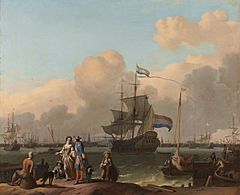
Weapons for 20,000 men were loaded onto three ships, along with about 300 men. Most of these men were Scots who had been serving in the Dutch army. After waiting for good winds, Argyll's forces left Amsterdam on May 2. They were blown by a strong wind and arrived near the Moray Firth on May 5. They planned to sail around the north of Orkney to reach the west coast. But the wind died, and a thick sea fog appeared. They missed the passage and anchored in Swanbister Bay in Orkney.
A disaster happened when Argyll's assistant, William Spence, went ashore to find a guide. He and his friend were arrested in Kirkwall. This told the authorities that the rebels were there. The rebels then took seven local gentlemen prisoner. Argyll tried to exchange them for his men, but got no answer. The rebels and their prisoners continued west. They reached the Sound of Mull on May 11. Argyll sent his son, Charles Campbell, to Lorne to gather local landowners who owed loyalty to his father. Meanwhile, the main force sailed south to Islay. Argyll decided to land most of his troops by night to surprise the King's soldiers. They landed at Kilarrow early on May 17.
The Uprising Begins
The King's men had left the area a few hours earlier, so the rebels landed at Kilarrow without a fight. The rebel soldiers looked well-equipped, but Argyll only managed to get 80 new recruits. He had expected 600. On May 20, the ships crossed to Campbeltown, where Argyll had a lot of influence. Here, he had two statements read aloud. The first said he only wanted to get his lands back.
The second statement, called the Declaration, was written by James Stewart of Goodtrees. It was a long list of complaints but did not clearly state what the rebels wanted to do next. This was a problem for the rebel leaders. The Covenanters, who were most likely to join, wanted to completely change the church. This would make many moderate people oppose them. The Covenanters also didn't trust Argyll because he had been part of the government that punished them in the past. Because the Declaration didn't mention their beliefs, many Covenanters did not join.
Argyll gathered his forces in Campbeltown on May 22. Three small groups of recruits had followed from Islay. More joined from Campbeltown. They were given Dutch weapons and flags with mottos like "For the Protestant Religion" and "Against Catholicism, Bishops and State control of the Church". Richard Rumbold and John Ayloffe were made colonels of regiments formed from the new recruits.
Disagreements Among Leaders
The original plan was to quickly move into the Lowlands to get support from Covenanters before government troops could stop them. This idea seemed good when George Barclay arrived, claiming hundreds of potential recruits were waiting. Some of the men recruited on Islay had already left the rebellion. Argyll ordered his forces to Tarbert, Kintyre, to meet with more Campbell clan members. On May 27, they were joined by 1,200 men, bringing their total strength to about 2,500.
However, there was no news that Monmouth had landed in England. This caused arguments among the rebel leaders. Argyll's lands were occupied by the King's soldiers, so he couldn't raise his tenants. He felt his clan members wouldn't fight while their homes were in danger. He first decided to march on Inveraray. But under pressure from his Council, he agreed to send a smaller force to the Lowlands by sea to start recruiting there. The next day, he changed his mind again. John Cochrane was so angry he said he would land on the Ayrshire coast "even if he were alone and had nothing but a hayfork".
Other leaders complained that Argyll was too bossy. Argyll accused them of deliberately blocking his plans. Unlike Monmouth, Argyll was not very popular, even among his own tenants. Their rents had gone up a lot. Another Campbell leader, Breadalbane, raised 800 men to fight for the government. Argyll's army never had more than 2,500 men. Some thought it was even fewer than 1,500. This was much less than the 8,000 who joined the 1679 rebellion.
Bute and Eilean Dearg

The rebels crossed to the Isle of Bute looking for more men and supplies. This didn't help much. They wasted three days looking for boats. Attempts to get more boats on Great Cumbrae failed when government soldiers arrived and destroyed them. Also, looting by the rebels reduced the number of new recruits. Sir Patrick Hume wanted to go to the Lowlands, but Argyll insisted they deal with the Marquess of Atholl first. They agreed to a compromise: Cochrane would go to Renfrewshire with 200 men. He defeated some soldiers near Greenock but found little support for the uprising. When he returned, he agreed with Argyll.
Argyll set up a base at the old castle of Eilean Dearg, Loch Riddon. They made it stronger with more earthworks. Once it was ready, their ships unloaded weapons and supplies there. Rumbold and his cavalry, along with 300 foot soldiers, were sent to hold Glendaruel. Rumbold also captured Ardkinglas Castle. Argyll saw this as a chance to take over all of Argyllshire, but his Council said no.
On June 11, the same day Monmouth finally landed in England, the Council decided to march to the Lowlands. They left a small group of soldiers at Eilean Dearg. Soon after, the King's navy attacked Eilean Dearg. The soldiers abandoned the fort, leaving behind their supplies and the hostages from Orkney. They rejoined their friends near Loch Long. News of this loss greatly hurt the rebels' spirits, and more and more men left the army.
March to the Lowlands
With few supplies left, the rebels decided to head for Glasgow, a city known for supporting Protestants. The Marquess of Atholl was chasing them. The Earl of Dumbarton was also waiting near Glasgow with soldiers. The rebels didn't know that some Covenanters had gathered to join them. But a preacher told them that Argyll and Monmouth had been part of the government that had punished them before. So, they didn't join.
By June 16, the rebels had fewer than 1,000 men because so many had left. They crossed the River Leven near Dumbarton. On the road to Stirling, they saw some government soldiers. Argyll, Cochrane, and Ayloffe wanted to attack right away, hoping a quick win would bring more support. But Hume insisted they continue to Glasgow. On June 17, a terrible night march caused the remaining forces to scatter. Rumbold and Argyll tried to keep order, but Rumbold got separated. Most of the Highlanders left. Argyll had a final meeting with Cochrane at an inn. Argyll was very tired and could barely speak.
Cochrane supposedly told Argyll to go back to the Highlands with his own clan members instead of crossing the River Clyde. But Argyll later said his Lowland friends abandoned him. He set off north with a small group of friends. After a few miles, the group broke up. Campbell of Auchinbreck tried to go to Argyllshire to gather more men. Argyll went south with only one companion. He disguised himself as a countryman. Two men stopped him while he was crossing a river and took him prisoner.
The Battle of Muirdykes
Cochrane, with Hume and about 150 men, had crossed the Clyde. After more men left and they fought off some soldiers, a group of 75 rebels reached a place called Muirdykes on June 18. They gathered in a small area protected by low stone walls. A group of dragoons (soldiers on horseback) attacked them. Cochrane refused to surrender. They successfully defended their position until nightfall. The King's soldiers had several injured, including their commander. Under the cover of darkness, the rebels moved away. They found that the dragoons had fled. Hume later wrote that if he had to choose 75 men for his life, he would choose those same men.
On June 20, Cochrane heard that Argyll had been captured. He told the remaining rebels they were free to escape as best they could. Cochrane was captured a week later. Rumbold was stopped by soldiers on the night of June 20/21. When told to surrender, he supposedly said he "came there to fight for death, not for life". He killed one attacker and wounded two. He was only captured when his horse was shot. He was brought to Edinburgh badly wounded.
Aftermath
Many people were surprised at how easily Argyll's Rising was defeated. Argyll was executed on June 30. He was put to death under the old treason charge from 1681. Many people noted how calm and cheerful he was while waiting for his execution. He spent much of his time asking that his tenants not be punished for helping him.
Rumbold was tried and executed on the same day, June 26. This was possibly to make sure he didn't die from his wounds first. Argyll, in his last letters, praised Rumbold, calling him "a great support to me and a brave man." Rumbold's last speech was widely printed. In it, he famously said, "none comes into this world with a saddle on his back, neither any booted and spurred to ride him..." John Ayloffe, another rebel, was executed in London on October 30.
Cochrane was said to have saved himself by agreeing to support King James. Another reason might be that his father agreed to pay a large fine of £5,000. Several other important rebels were pardoned. Argyll's nephew, Archibald, later became a bishop. Campbell of Auchinbreck escaped to Holland and returned after the Glorious Revolution. He later asked Parliament for help, saying that rival clan members had destroyed his castle, stolen cattle, and killed his relatives.
Of the regular rebel soldiers, 177 were sent to Jamaica and 100 to New Jersey. Hundreds of Covenanters already in prison suffered worse treatment, even though they hadn't joined the rebellion. Many of them were also sent away. However, the punishments for Argyll's Rising were generally less severe than for Monmouth's Rebellion. This might be because the authorities knew many of Argyll's men felt forced to follow him due to old traditions. Even though Argyll's Rising failed, many people involved in it later took part in the Glorious Revolution a few years later.
Images for kids
-
Archibald Campbell, 9th Earl of Argyll was found guilty of treason in 1681. He escaped to the Dutch Republic in 1683.
-
The port of Amsterdam around 1680. The rebels sailed from here on May 2, 1685.
-
Rothesay Castle on Bute was burned by Argyll's forces when they left for the mainland.


